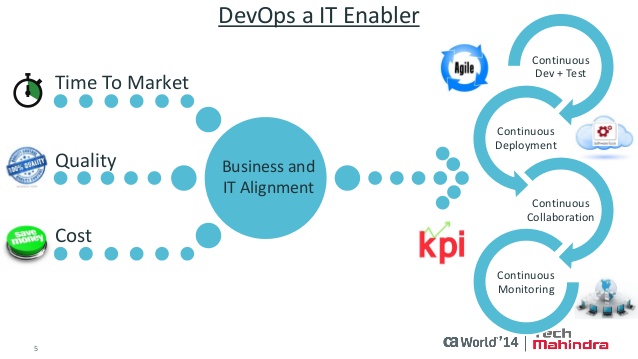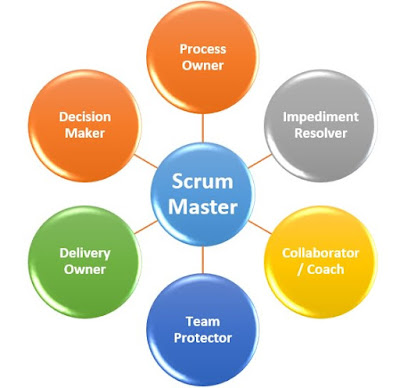What Is DevOps?
DevOps (a clipped compound of development and operations) is a term used to refer to a set of practices that emphasizes the collaboration and communication of both software developers and other information-technology (IT) professionals while automating the process of software delivery and infrastructure changes. It aims at establishing a culture and environment where building, testing, and releasing software can happen rapidly, frequently, and more reliablyWhere Did DevOps Come From?
DevOps is the offspring of agile software development – born from the need to keep up with the increased software velocity and throughput agile methods have achieved. Advancements in agile culture and methods over the last decade exposed the need for a more holistic approach to the end-to-end software delivery lifecycle.
The DevOps ideals extend agile development practices by further streamlining the movement of software change thru the build, validate, and deploy and delivery stages, while empowering cross-functional teams with full ownership of software applications – from design thru production support.
DevOps is an IT mindset that encourages communication, collaboration, integration and automation among software developers and IT operations in order to improve the speed and quality of delivering software.
DevOps teams focus on standardizing development environments and automating delivery processes to improve delivery predictability, efficiency, security and maintainability. The DevOps ideals provide developers more control of the production environment and a better understanding of the production infrastructure. DevOps encourages empowering teams with the autonomy to build, validate, deliver and support their own applications. With DevOps, nothing gets “thrown over the wall.”
DevOps teams focus on standardizing development environments and automating delivery processes to improve delivery predictability, efficiency, security and maintainability. The DevOps ideals provide developers more control of the production environment and a better understanding of the production infrastructure. DevOps encourages empowering teams with the autonomy to build, validate, deliver and support their own applications. With DevOps, nothing gets “thrown over the wall.”
What Are the Challenges DevOps Solves ?
Prior to DevOps application development, teams were in charge of gathering business requirements for a software program and writing code. Then a separate QA team tests the program in an isolated development environment, if requirements were met, and releases the code for operations to deploy. The deployment teams are further fragmented into siloed groups like networking and database. Each time a software program is “thrown over the wall” to an independent team it adds bottlenecks.
The problem with this paradigm is that when the teams work separately:
- Dev is often unaware of QA and Ops roadblocks that prevent the program from working as anticipated.
- QA and Ops are typically working across many features and have little context of the business purpose and value of the software.
- Each group has opposing goals that can lead to inefficiency and finger pointing when something goes wrong.
DevOps addresses these challenges by establishing collaborative cross-functional teams that share responsibility for maintaining the system that runs the software and preparing the software to run on that system with increased quality feedback and automation issues.
What Is the Goal of DevOps?
Improve collaboration between all stakeholders from planning through delivery and automation of the delivery process in order to:
- Improve deployment frequency
- Achieve faster time to market
- Lower failure rate of new releases
- Shorten lead time between fixes
- Improve mean time to recovery
What Tools Are Used in DevOps?
Earlier we briefly discussed some of the tools used in DevOps; here are some of the key tools and practices you need to know.
Source Code Repository
A source code repository is a place where developers check in and change code. The source code repository manages the various versions of code that are checked in, so developers don’t write over each other’s work.
A source code repository is a place where developers check in and change code. The source code repository manages the various versions of code that are checked in, so developers don’t write over each other’s work.
Source control has probably been around for forty years, but it’s a major component of continuous integration. Popular source code repository tools are Git, Subversion, Cloudforce, Bitbucket and TFS.
Build Server
The build server is an automation tool that compiles the code in the source code repository into executable code base. Popular tools are Jenkins, SonarQube and Artifactory.
The build server is an automation tool that compiles the code in the source code repository into executable code base. Popular tools are Jenkins, SonarQube and Artifactory.
Configuration Management
Configuration management defines the configuration of a server or an environment. Popular configuration management tools are Puppet and Chef.
Configuration management defines the configuration of a server or an environment. Popular configuration management tools are Puppet and Chef.
Virtual Infrastructure
Amazon Web Services and Microsoft Azure are examples of virtual infrastructures. Virtual infrastructures are provided by cloud vendors that sell infrastructure or platform as a service (PaaS). These infrastructures have APIs to allow you to programmatically create new machines with configuration management tools such as Puppet and Chef.
Amazon Web Services and Microsoft Azure are examples of virtual infrastructures. Virtual infrastructures are provided by cloud vendors that sell infrastructure or platform as a service (PaaS). These infrastructures have APIs to allow you to programmatically create new machines with configuration management tools such as Puppet and Chef.
There are also private clouds. For example, VMware has vCloud. Private virtual infrastructures enable you to run a cloud on top of the hardware in your data center.
Virtual infrastructures combined with automation tools to empower organizations practicing DevOps with the ability to configure a server without any fingers on the keyboard. If you want to test your brand-new code, you can automatically send it to your cloud infrastructure, build the environment and then run all of the tests without human intervention.
Test Automation
Test automation has been around for a long time. DevOps testing focuses on automated testing within your build pipeline to ensure that by the time that you have a deployable build, you are confident it is ready to be deployed. You can’t get to the point of continuous delivery where you’re fairly confident without any human intervention that your code is deployable without an extensive automated testing strategy. Popular tools are Selenium and Water.
Test automation has been around for a long time. DevOps testing focuses on automated testing within your build pipeline to ensure that by the time that you have a deployable build, you are confident it is ready to be deployed. You can’t get to the point of continuous delivery where you’re fairly confident without any human intervention that your code is deployable without an extensive automated testing strategy. Popular tools are Selenium and Water.
Pipeline Orchestration
A pipeline is like a manufacturing assembly line that happens from the time a developer says, “I think I’m done,” all the way to the time that the code gets deployed in the production or a late-stage pre-production environment.
Unifying Enterprise Software Development and Delivery
The VersionOne Enterprise Agile Platform unifies agile application lifecycle management and DevOps, providing a full picture of your entire software delivery pipeline in a single platform. VersionOne® Continuum™ for DevOps is an enterprise continuous delivery solution for automating, orchestrating, and visualizing the flow of change throughout the software delivery cycle.
A pipeline is like a manufacturing assembly line that happens from the time a developer says, “I think I’m done,” all the way to the time that the code gets deployed in the production or a late-stage pre-production environment.
Unifying Enterprise Software Development and Delivery
The VersionOne Enterprise Agile Platform unifies agile application lifecycle management and DevOps, providing a full picture of your entire software delivery pipeline in a single platform. VersionOne® Continuum™ for DevOps is an enterprise continuous delivery solution for automating, orchestrating, and visualizing the flow of change throughout the software delivery cycle.
 |
| The conflicts and complaints wall |






Comentarios
Publicar un comentario